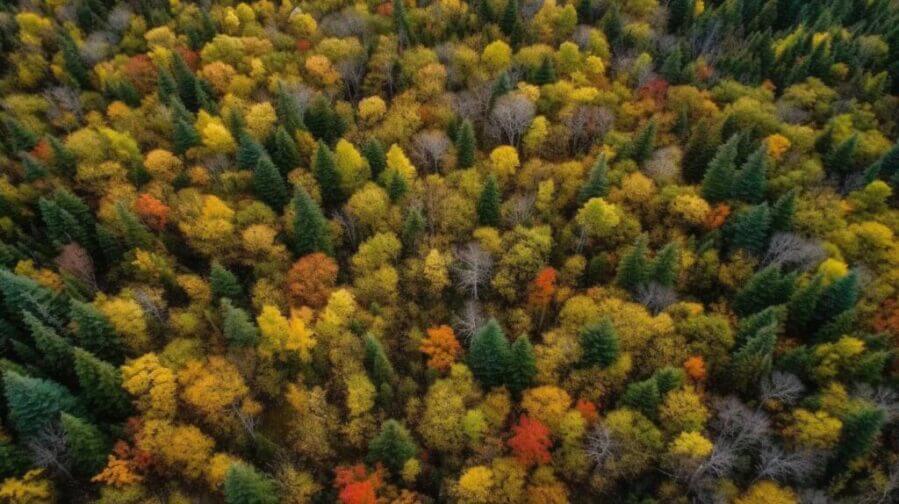Preserving the diversity of forests assures their productivity and potentially increases the accumulation of carbon and nitrogen in the soil, which helps to sustain soil fertility and mitigate global climate change.
That’s the main takeaway from a new study that analyzed data from hundreds of plots in Canada’s National Forest Inventory to investigate the relationship between tree diversity and changes in soil carbon and nitrogen in natural forests.
Numerous biodiversity-manipulation experiments have collectively suggested that higher tree diversity can lead to greater accumulation of carbon and nitrogen in forest soils. But the new study, published online April 26 in the journal Nature, is the first to show a similar outcome in natural forests, according to the authors.
The researchers used a statistical method called structural equation modeling to assess relationships between tree diversity and soil carbon and nitrogen accumulation. They found that increased tree diversity enhanced soil carbon storage by 30% to 32% and enhanced nitrogen storage by 42% to 50% on a decadal timescale.
“Our study, for the first time, shows the sustained benefits of tree diversity in storing soil carbon and nitrogen in natural forests,” said study lead author Xinli Chen, a postdoctoral exchange fellow at U-M’s Institute for Global Change Biology and a postdoctoral fellow at the University of Alberta.
“Our results highlight that promoting tree diversity not only increases productivity but also mitigates global climate change and reduces soil degradation. And the size of the diversity dividend is large. It reinforces the importance of biodiversity conservation in forests and will guide the growing efforts to use forests for carbon and nitrogen sequestration.”
The researchers calculated changes in soil carbon and nitrogen storage over time by comparing data from two National Forest Inventory sample-plot censuses, one from 2000-2006 and the other from 2008-2017.
They quantified tree diversity as species richness, species evenness, and—on the basis of trees’ functional traits—functional diversity.
Species richness is the number of tree species in a sample plot, while species evenness is a measure of the relative abundances of tree species. Functional diversity is the variety of functional traits—such as leaf nitrogen content and adult tree height—of tree species within a community.
The research team found that increasing species evenness from its minimum to its maximum value enhanced carbon storage in the organic soil layer by 30% and nitrogen storage by 42%. Increasing the functional diversity of trees to its maximum value enhanced carbon storage in the soil mineral layer by 32% and nitrogen storage by 50%.
“We find that greater tree diversity is associated with higher soil carbon and nitrogen accumulation, validating inferences from biodiversity-manipulation experiments,” said study co-author Peter Reich, a forest ecologist and director of the Institute for Global Change Biology, which is part of U-M’s School for Environment and Sustainability.
“A greater diversity of species translates into a mixture of different types of trees with different ways of acquiring and storing biomass—both in live trunks, roots, branches and leaves and in newly dead and decaying plant detritus on and in the soil.”
Canada’s National Forest Inventory database is based on a network of plots covering much of the country’s landmass. The new study analyzed organic soil horizon samples from 361 plots and mineral soil horizon samples from 245 plots.
Those plots are home to various species of fir, maple, birch, spruce, pine, poplar, cedar and hemlock, among other tree types.
Forest soils play an important role in sequestering carbon extracted from planet-warming carbon dioxide gas during photosynthesis. Those soils store at least three times as much carbon as living plants do.
Nitrogen is an essential nutrient that drives carbon assimilation and plant growth in forest ecosystems. Plant diversity is rapidly declining globally, leading to the degradation of ecosystem function, including the function of soils.
The other authors of the Nature study are Anthony Taylor of the University of New Brunswick, Masumi Hisano of the University of Tokyo, Han Chen of Lakehead University, and Scott Chang of the University of Alberta and Zhejiang A&F University.
The research was supported by the Discovery Grants program of the Natural Sciences and Engineering Research Council of Canada, the Canada Foundation for Innovation, the Ontario Research Fund, the Banting Postdoctoral Fellowship, and a grant from the U.S. National Science Foundation’s Biological Integration Institutes.

